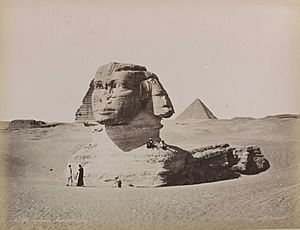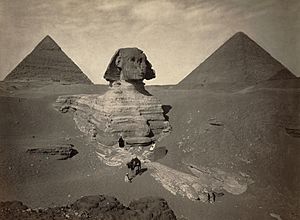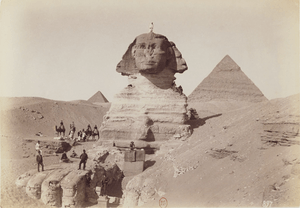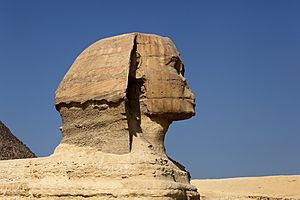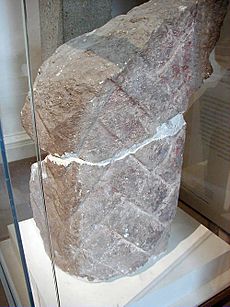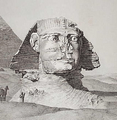The Great Sphinx facts for kids
The Great Sphinx is a huge stone statue in Giza, near Cairo in Egypt. It looks like a creature with the body of a lion and the head of a human. You can find it sitting south of the pyramid of Pharaoh Khafre, on the west bank of the Nile River.
This amazing sculpture is one of the biggest and oldest in the world. Its body is about 60 meters (200 feet) long, and it stands 20 meters (65 feet) tall. The face alone is 4 meters (13 feet) wide!
Many experts believe the Sphinx is much older than the time of Pharaoh Khafre (around 2575-2467 BCE). They think Khafre might have restored it during his rule. The name 'Sphinx' means 'strangler,' but no one knows for sure why it was built. Some archaeologists think it was a memorial to a pharaoh or a kind of guardian god. Others believe it was used to watch the stars, marking where the sun rose on the first day of spring.
Today, the Sphinx is slowly wearing away because of wind, humidity, and pollution from Cairo. People have tried to fix it many times, but sometimes these efforts caused more damage. Now, archaeologists are carefully working to restore it, even trying to drain away underground water that can harm the stone.
Contents
How the Sphinx Was Built
The Sphinx was carved right out of the natural rock of the plateau. This same rock was also used as a quarry, meaning it was a source of stone for building the pyramids and other monuments nearby.
The limestone rock in the area has different layers. Some layers are harder and resist wearing away, while others are softer. This is why parts of the Sphinx's body have worn down unevenly. The lowest part, including its legs, is made of very strong rock. The lion's body, up to its neck, is from softer layers that have worn away a lot. The stone used for the head is much harder.
Who Built the Sphinx?

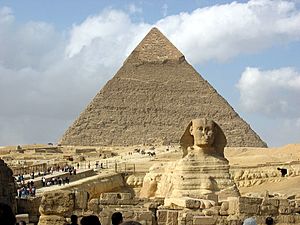
The Great Sphinx is one of the world's most famous statues. Yet, we still don't know many basic facts about it. For example, exactly when it was built, who built it, and why are still debated.
What Was the Sphinx Called?
We don't know what the people who built the Sphinx originally called it. The Great Sphinx isn't mentioned in any known writings from the Old Kingdom. There are also no writings that describe how it was built or its first purpose.
Later, in the New Kingdom, the Sphinx was called Hor-em-akhet. This means "Horus of the Horizon." Pharaoh Thutmose IV (who ruled around 1400 BC) even mentioned it by this name in a famous story called the "Dream Stele."
The name "Sphinx" that we use today was given to it much later by the ancient Greeks. This was about 2000 years after the Sphinx was built. They named it after a monster in their own myths that had a lion's body, a woman's head, and eagle wings. However, most Egyptian sphinxes, like the Great Sphinx, have a man's head and no wings.
Who Built It and When?
Most modern Egyptologists believe the Great Sphinx was built around 2500 BC. They think it was made for the pharaoh Khafre, who also built the Second Pyramid at Giza.
However, there isn't a single ancient writing that directly connects the Sphinx to Khafre. So, the idea that Khafre built it is still not fully proven. One piece of evidence that supports this idea is a statue of Khafre. It was found buried upside down near the Sphinx, along with other items.
Missing Nose and Beard
The Sphinx's nose, which was about one meter (three feet) wide, is missing. When experts looked closely at the Sphinx's face, they saw marks that suggest long rods or chisels were hammered into the nose. It seems these tools were used to pry the nose off.
There's a popular story that Napoleon's soldiers broke off the nose with a cannonball. But this isn't true! Drawings of the Sphinx made by a Danish traveler named Frederic Louis Norden in 1737 already show the Sphinx without its nose. Napoleon wasn't even born until 1769. Other stories blame British troops or the Mamluks, but the drawings prove the nose was gone before these events.
The Sphinx is also thought to have once had a special ceremonial beard, like those worn by pharaohs. However, this beard might have been added much later, after the Sphinx was first built. One Egyptologist, Vassil Dobrev, thinks that if the beard had been part of the original statue, it would have damaged the chin when it fell off. Since there's no visible damage, it supports the idea that the beard was a later addition.
You can still see traces of red paint on parts of the Sphinx's face. There are also tiny bits of yellow and blue paint found elsewhere on the statue. This suggests that the Sphinx might have once been painted in bright, "comic book-like colors."
Images for kids
-
Description de l'Egypte (Panckoucke edition), Planches, Antiquités, volume V (1823), also published in the Imperial edition of 1822.
-
Description de l'Egypte (Panckoucke edition), Planches, Antiquités, volume V (1823), also published in the Imperial edition of 1822.
-
Jean-Léon Gérôme's Bonaparte Before the Sphinx, 1867–1868.
See also
 In Spanish: Gran Esfinge de Guiza para niños
In Spanish: Gran Esfinge de Guiza para niños


